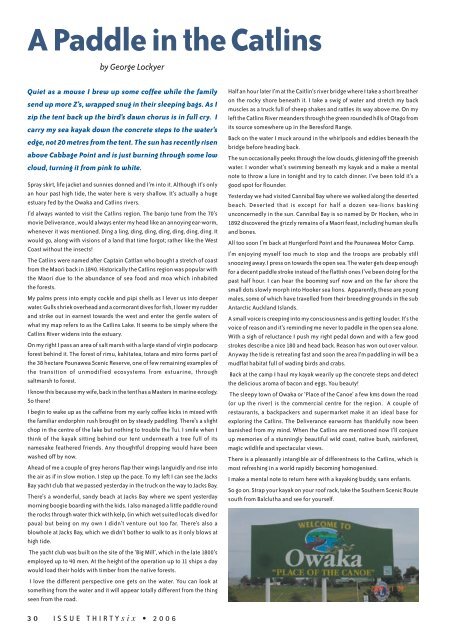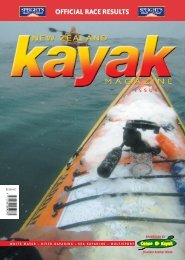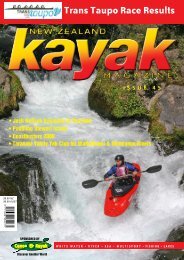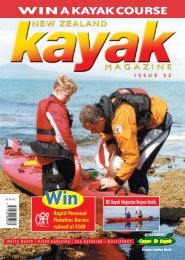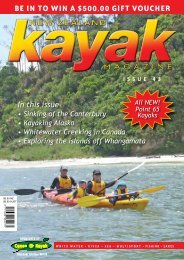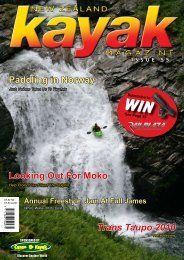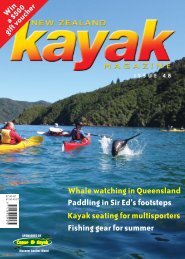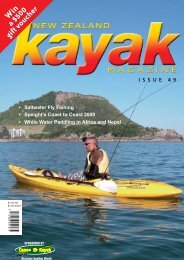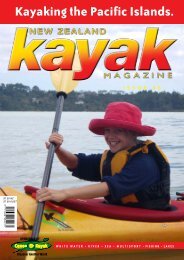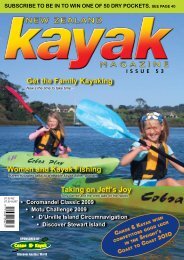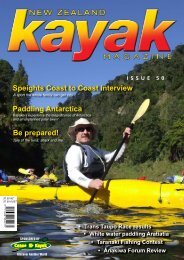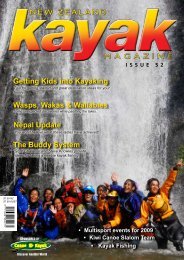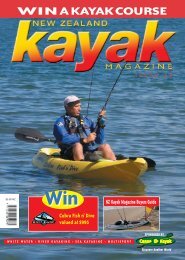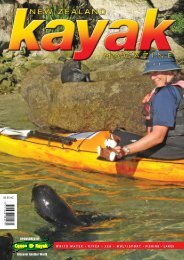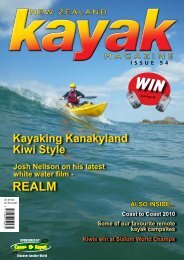You also want an ePaper? Increase the reach of your titles
YUMPU automatically turns print PDFs into web optimized ePapers that Google loves.
A Paddle in the Catlins<br />
by George Lockyer<br />
Quiet as a mouse I brew up some coffee while the family<br />
send up more Z’s, wrapped snug in their sleeping bags. As I<br />
zip the tent back up the bird’s dawn chorus is in full cry. I<br />
carry my sea kayak down the concrete steps to the water’s<br />
edge, not 20 metres from the tent. The sun has recently risen<br />
above Cabbage Point and is just burning through some low<br />
cloud, turning it from pink to white.<br />
Spray skirt, life jacket and sunnies donned and I’m into it. Although it’s only<br />
an hour past high tide, the water here is very shallow. It’s actually a huge<br />
estuary fed by the Owaka and Catlins rivers.<br />
I’d always wanted to visit the Catlins region. The banjo tune from the 70’s<br />
movie Deliverance , would always enter my head like an annoying ear-worm,<br />
whenever it was mentioned. Ding a ling, ding, ding, ding, ding, ding, ding. It<br />
would go, along with visions of a land that time forgot; rather like the West<br />
Coast without the insects!<br />
The Catlins were named after Captain Cattlan who bought a stretch of coast<br />
from the Maori back in 1840. Historically the Catlins region was popular with<br />
the Maori due to the abundance of sea food and moa which inhabited<br />
the forests.<br />
My palms pre<strong>ss</strong> into empty cockle and pipi shells as I lever us into deeper<br />
water. Gulls shriek overhead and a cormorant dives for fish, I lower my rudder<br />
and strike out in earnest towards the west and enter the gentle waters of<br />
what my map refers to as the Catlins Lake. It seems to be simply where the<br />
Catlins River widens into the estuary.<br />
On my right I pa<strong>ss</strong> an area of salt marsh with a large stand of virgin podocarp<br />
forest behind it. The forest of rimu, kahitatea, totara and miro forms part of<br />
the 38 hectare Pounawea Scenic Reserve, one of few remaining examples of<br />
the transition of unmodified ecosystems from estuarine, through<br />
saltmarsh to forest.<br />
I know this because my wife, back in the tent has a Masters in marine ecology.<br />
So there!<br />
I begin to wake up as the caffeine from my early coffee kicks in mixed with<br />
the familiar endorphin rush brought on by steady paddling. There’s a slight<br />
chop in the centre of the lake but nothing to trouble the Tui. I smile when I<br />
think of the kayak sitting behind our tent underneath a tree full of its<br />
namesake feathered friends. Any thoughtful dropping would have been<br />
washed off by now.<br />
Ahead of me a couple of grey herons flap their wings languidly and rise into<br />
the air as if in slow motion. I step up the pace. To my left I can see the Jacks<br />
Bay yacht club that we pa<strong>ss</strong>ed yesterday in the truck on the way to Jacks Bay.<br />
There’s a wonderful, sandy beach at Jacks Bay where we spent yesterday<br />
morning boogie boarding with the kids. I also managed a little paddle round<br />
the rocks through water thick with kelp, (in which wet suited locals dived for<br />
paua) but being on my own I didn’t venture out too far. There’s also a<br />
blowhole at Jacks Bay, which we didn’t bother to walk to as it only blows at<br />
high tide.<br />
The yacht club was built on the site of the ‘Big Mill’, which in the late 1800’s<br />
employed up to 40 men. At the height of the operation up to 11 ships a day<br />
would load their holds with timber from the native forests.<br />
I love the different perspective one gets on the water. You can look at<br />
something from the water and it will appear totally different from the thing<br />
seen from the road.<br />
Half an hour later I’m at the Caitlin’s river bridge where I take a short breather<br />
on the rocky shore beneath it. I take a swig of water and stretch my back<br />
muscles as a truck full of sheep shakes and rattles its way above me. On my<br />
left the Catlins River meanders through the green rounded hills of Otago from<br />
its source somewhere up in the Beresford Range.<br />
Back on the water I muck around in the whirlpools and eddies beneath the<br />
bridge before heading back.<br />
The sun occasionally peeks through the low clouds, glistening off the greenish<br />
water. I wonder what’s swimming beneath my kayak and a make a mental<br />
note to throw a lure in tonight and try to catch dinner. I’ve been told it’s a<br />
good spot for flounder.<br />
Yesterday we had visited Cannibal Bay where we walked along the deserted<br />
beach. Deserted that is except for half a dozen sea-lions basking<br />
unconcernedly in the sun. Cannibal Bay is so named by Dr Hocken, who in<br />
1892 discovered the grizzly remains of a Maori feast, including human skulls<br />
and bones.<br />
All too soon I’m back at Hungerford Point and the Pounawea Motor Camp.<br />
I’m enjoying myself too much to stop and the troops are probably still<br />
snoozing away. I pre<strong>ss</strong> on towards the open sea. The water gets deep enough<br />
for a decent paddle stroke instead of the flattish ones I’ve been doing for the<br />
past half hour. I can hear the booming surf now and on the far shore the<br />
small dots slowly morph into Hooker sea lions. Apparently, these are young<br />
males, some of which have travelled from their breeding grounds in the sub<br />
Antarctic Auckland Islands.<br />
A small voice is creeping into my consciousne<strong>ss</strong> and is getting louder. It’s the<br />
voice of reason and it’s reminding me never to paddle in the open sea alone.<br />
With a sigh of reluctance I push my right pedal down and with a few good<br />
strokes describe a nice 180 and head back. Reason has won out over valour.<br />
Anyway the tide is retreating fast and soon the area I’m paddling in will be a<br />
mudflat habitat full of wading birds and crabs.<br />
Back at the camp I haul my kayak wearily up the concrete steps and detect<br />
the delicious aroma of bacon and eggs. You beauty!<br />
The sleepy town of Owaka or ‘Place of the <strong>Canoe</strong>’ a few kms down the road<br />
(or up the river) is the commercial centre for the region. A couple of<br />
restaurants, a backpackers and supermarket make it an ideal base for<br />
exploring the Catlins. The Deliverance earworm has thankfully now been<br />
banished from my mind. When the Catlins are mentioned now I’ll conjure<br />
up memories of a stunningly beautiful wild coast, native bush, rainforest,<br />
magic wildlife and spectacular views.<br />
There is a pleasantly intangible air of differentne<strong>ss</strong> to the Catlins, which is<br />
most refreshing in a world rapidly becoming homogenised.<br />
I make a mental note to return here with a kayaking buddy, sans enfants.<br />
So go on. Strap your kayak on your roof rack, take the Southern Scenic Route<br />
south from Balclutha and see for yourself.<br />
30 ISSUE THIRTYsix • 2006


